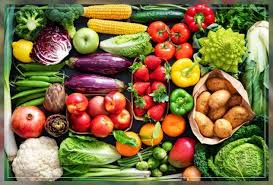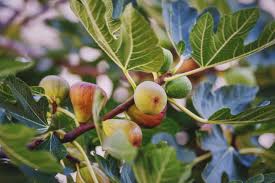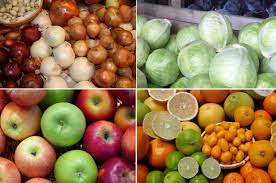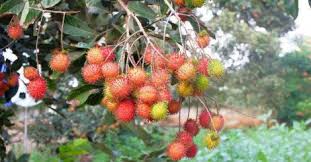Fruits and vegetables are essential components of our diets and play a significant role in agriculture. They provide vital nutrients, enhance food security, and contribute to economic stability.
Understanding the cultivation and nutritional value of these crops is crucial for both farmers and consumers. This article will explore the importance of fruits and vegetables in agriculture, their classification, climatic requirements for growth, common fruit and vegetable crops along with their cultivation techniques, and their nutritional value.
Importance of Fruits and Vegetables in Agriculture
Fruits and vegetables are not only vital for human nutrition but also contribute significantly to agricultural economies. Here are some key reasons for their importance:
Nutritional Benefits
1. Essential Vitamins and Minerals: Fruits and vegetables are rich in vitamins (like A, C, and K) and minerals (like potassium and magnesium) that are essential for human health.
2. Dietary Fiber: They provide dietary fiber, which aids digestion and helps prevent various health issues, including obesity and heart disease.
Economic Value
1. Income Generation: Many farmers rely on fruit and vegetable crops as their primary source of income. Selling these products can be more profitable than growing cereals.
2. Market Demand: There is a high demand for fresh produce in local, national, and international markets, providing opportunities for farmers to expand their businesses.
Environmental Benefits
1. Biodiversity: Growing a variety of fruits and vegetables promotes biodiversity, which is essential for healthy ecosystems.
2. Soil Health: Certain crops can improve soil health and structure, making them beneficial for crop rotation practices.
Food Security
1. Availability of Fresh Produce: Fruits and vegetables are critical for food security, providing essential nutrients to populations worldwide.
2. Local Production: Growing these crops locally reduces dependency on imported food, enhancing self-sufficiency.
Classification of Fruits and Vegetable Crops

Fruits and vegetables can be classified based on various factors, including botanical characteristics, growth habits, and culinary uses. Here are some common classifications:
Botanical Classification
1. Fruits: Botanically, fruits are the mature ovary of a flower, usually containing seeds. Examples include apples, tomatoes, and cucumbers.
2. Vegetables: Vegetables include other plant parts such as leaves (lettuce), stems (celery), roots (carrots), and bulbs (onions).
Culinary Classification
1. Fruits: In culinary terms, fruits are often sweet or tart and used in desserts, snacks, and juices.
2. Vegetables: Vegetables are generally savory and used in main dishes, soups, and salads.
Growth Habit
1. Annuals: These plants complete their life cycle in one year. Common examples are lettuce and spinach.
2. Perennials: These plants live for more than two years. Examples include fruit trees like apple and pear.
Climatic Requirements for Growing Fruits and Vegetables
Fruits and vegetables have specific climatic needs for optimal growth. Understanding these requirements helps in selecting suitable crops for cultivation.
Temperature
1. Warm-Season Crops: These crops, like tomatoes and peppers, thrive in warm temperatures (60°F to 85°F or 15°C to 29°C).
2. Cool-Season Crops: These include peas and spinach, which prefer cooler temperatures (45°F to 75°F or 7°C to 24°C).
Light
1. Full Sun: Most fruits and vegetables require full sunlight (6 to 8 hours of direct sunlight daily) for optimal growth.
2. Partial Shade: Some crops, like lettuce, can tolerate partial shade.
Water
1. Irrigation Needs: Consistent watering is crucial, especially during dry spells. Most crops require 1 to 2 inches of water per week.
2. Drainage: Good soil drainage is essential to prevent waterlogging, which can harm roots.
Soil Quality
1. Nutrient-Rich Soil: Fruits and vegetables thrive in well-drained, nutrient-rich soils. Adding organic matter like compost can enhance soil fertility.
2. pH Levels: Most crops prefer slightly acidic to neutral soil (pH 6.0 to 7.5).
Read Also: The Major Causes of Cannibalism among Poultry Birds
Common Fruit Crops and Their Cultivation Techniques

Fruits can be grown in various climates and soil types. Here are some common fruit crops along with their cultivation techniques:
Apples
1. Planting: Plant apple trees in early spring or fall in well-drained soil with full sun exposure.
2. Care: Water regularly, especially during dry periods. Prune trees annually to promote healthy growth and fruit production.
3. Pest Management: Monitor for pests and diseases, and apply organic pesticides as needed.
Tomatoes
1. Planting: Start seeds indoors 6-8 weeks before the last frost. Transplant seedlings outdoors after the danger of frost has passed.
2. Care: Water consistently and use mulch to retain moisture. Stake or cage plants for support.
3. Harvesting: Harvest when tomatoes are firm and fully colored.
Bananas
1. Planting: Plant banana suckers in well-drained, nutrient-rich soil in warm, tropical climates.
2. Care: Water regularly and provide plenty of nutrients. Mulch to retain moisture and suppress weeds.
3. Harvesting: Harvest bananas when they are plump and still green, allowing them to ripen off the plant.
Read Also: 15 MANAGEMENT TIPS FOR BETTER POULTRY PERFORMANCE
Common Vegetable Crops and Their Cultivation Techniques

Vegetables are also versatile and can be grown in various conditions. Here are some common vegetable crops with cultivation techniques:
Carrots
1. Planting: Sow carrot seeds directly in loose, well-drained soil in early spring or late summer.
2. Care: Keep the soil consistently moist. Thin seedlings to avoid overcrowding.
3. Harvesting: Harvest when roots are firm and have reached the desired size, usually about 2-3 months after planting.
Spinach
1. Planting: Sow seeds in early spring or fall in well-drained, nutrient-rich soil.
2. Care: Water regularly and keep the area weed-free. Spinach prefers cooler temperatures.
3. Harvesting: Harvest leaves when they are young and tender, typically within 4-6 weeks.
Peppers
1. Planting: Start seeds indoors 8-10 weeks before the last frost, and transplant them outdoors after the frost danger has passed.
2. Care: Water consistently and fertilize regularly to promote fruit development.
3. Harvesting: Harvest peppers when they reach the desired size and color, usually about 60-90 days after planting.
Nutritional Value of Fruits and Vegetables
Fruits and vegetables are packed with nutrients that are essential for health:
Vitamins
1. Vitamin A: Found in carrots, sweet potatoes, and leafy greens, it is vital for eye health.
2. Vitamin C: Present in citrus fruits, strawberries, and bell peppers, it supports the immune system and skin health.
Minerals
1. Potassium: Found in bananas and potatoes, it helps regulate blood pressure.
2. Magnesium: Present in leafy greens and nuts, it plays a role in muscle function and energy production.
Antioxidants
1. Health Benefits: Many fruits and vegetables contain antioxidants that protect the body from oxidative stress and reduce the risk of chronic diseases.
2. Examples: Berries, tomatoes, and broccoli are excellent sources of antioxidants.
Fiber
1. Digestive Health: The fiber in fruits and vegetables helps regulate digestion and prevent constipation.
2. Weight Management: High-fiber foods promote a feeling of fullness, which can aid in weight management.
Low Calories
1. Healthy Snacking: Fruits and vegetables are generally low in calories, making them ideal for healthy snacking.
2. Balanced Diet: Incorporating a variety of fruits and vegetables into your diet supports overall health.
Harvesting and Post-Harvest Handling

Harvesting and post-harvest handling are critical steps in ensuring that fruits and vegetables reach consumers in good condition.
Harvesting Techniques
1. Timing: Harvest crops at their peak ripeness for the best flavor and nutrition.
2. Method: Use proper techniques, such as cutting or twisting, to avoid damaging the plants.
Post-Harvest Handling
1. Cleaning: Remove dirt and debris from harvested crops without bruising them.
2. Storage: Store fruits and vegetables in cool, dry conditions to extend shelf life. Use appropriate containers to prevent spoilage.
Pests and Diseases Affecting Fruits and Vegetables
Pests and diseases can significantly impact fruit and vegetable production. Here are some common issues:
Common Pests
1. Aphids: These small insects suck plant sap, weakening plants and spreading diseases.
2. Caterpillars: Larvae of moths and butterflies can chew through leaves and fruits.
Common Diseases
1. Powdery Mildew: This fungal disease appears as white spots on leaves and can reduce crop yields.
2. Blight: Fungal infections that cause wilting and browning, affecting crops like tomatoes and potatoes.
Control Measures
1. Integrated Pest Management (IPM): Combine cultural, biological, and chemical methods to manage pests and diseases effectively.
2. Regular Monitoring: Keep an eye on crops for early signs of pests or diseases to take action quickly.
Organic Farming Practices for Fruits and Vegetables
Organic farming emphasizes sustainable practices and avoids synthetic chemicals. Here are some key methods:
Soil Health
1. Composting: Use organic waste to create nutrient-rich compost that improves soil fertility.
2. Crop Rotation: Rotate crops to enhance soil health and reduce pest and disease buildup.
Pest Management
1. Natural Predators: Introduce beneficial insects that prey on pests, such as ladybugs and lacewings.
2. Organic Pesticides: Use natural substances like neem oil or insecticidal soap to manage pests.
Fertilization
1. Organic Fertilizers: Use compost, manure, and other organic materials to provide nutrients to crops.
2. Mulching: Apply organic mulch to retain soil moisture and suppress weeds.
Modern Technologies in Fruit and Vegetable Farming
Technology is transforming fruit and vegetable farming, making it more efficient and productive.
1. Precision Agriculture
1. GPS and Drones: Use GPS technology and drones to monitor crop health and manage irrigation more effectively.
2. Soil Sensors: Install sensors to monitor soil moisture and nutrient levels for better decision-making.
Hydroponics and Vertical Farming
1. Hydroponics: Grow plants in nutrient-rich water without soil, allowing for year-round production.
2. Vertical Farming: Utilize vertical space to grow crops in urban areas, maximizing production in limited spaces.
Automation
1. Robotics: Use robots for planting, harvesting, and packing to reduce labor costs and improve efficiency.
2. Smart Irrigation: Implement smart irrigation systems that adjust water supply based on weather conditions and soil moisture.
Marketing and Export of Fruits and Vegetables
Successfully marketing fruits and vegetables is crucial for profitability.
Local Markets
1. Farmers’ Markets: Sell directly to consumers at local markets, which can improve profits and build customer relationships.
2. Community Supported Agriculture (CSA): Create subscription services where customers receive fresh produce weekly.
Export Opportunities
1. Regulatory Compliance: Understand international trade regulations and ensure that products meet quality standards for export.
2. Packaging and Transportation: Use appropriate packaging to preserve freshness during transport, and choose reliable logistics partners.
Challenges in Fruit and Vegetable Production
Despite the benefits, fruit and vegetable production faces several challenges.
Climate Change
1. Weather Variability: Changes in weather patterns can impact crop yields and increase pest pressure.
2. Extreme Weather: Droughts, floods, and storms can damage crops and disrupt production.
Labor Shortages
1. Availability of Workers: Many farms struggle to find enough labor during peak harvest seasons.
2. Labor Costs: Rising labor costs can squeeze profit margins for farmers.
Market Fluctuations
1. Price Volatility: Prices for fruits and vegetables can fluctuate based on supply and demand, affecting farmers’ incomes.
2. Consumer Preferences: Changes in consumer preferences can impact sales and market viability.
Fruits and vegetables are essential components of agriculture and human nutrition. Their importance extends beyond dietary needs to economic and environmental benefits. Understanding the classification, climatic requirements, cultivation techniques, and nutritional value of these crops is crucial for farmers and consumers alike.
By promoting the growth and consumption of fruits and vegetables, we can support sustainable agriculture and improve global health. Whether you are a farmer, a gardener, or simply a food lover, appreciating the role of these crops can enhance our connection to the food we eat and the environment we share.
Do you have any questions, suggestions, or contributions? If so, please feel free to use the comment box below to share your thoughts. We also encourage you to kindly share this information with others who might benefit from it. Since we can’t reach everyone at once, we truly appreciate your help in spreading the word. Thank you so much for your support and for sharing!
Read Also: Tips for Maintaining a Clean Garbage Disposal
Frequently Asked Questions
We will update this section soon.
